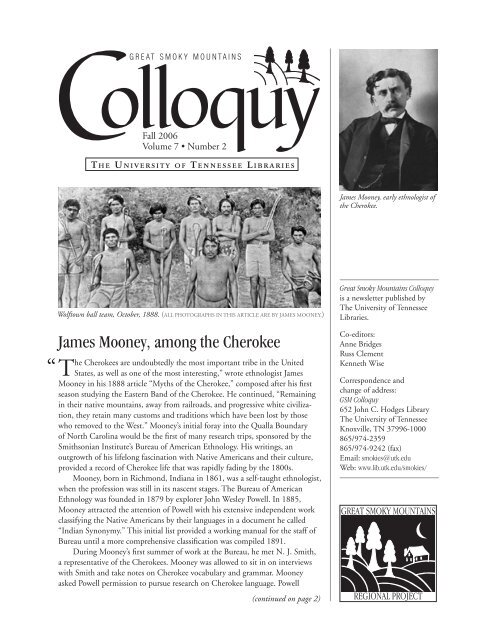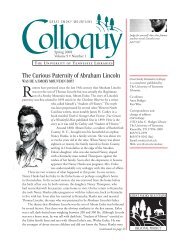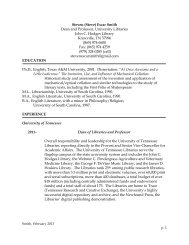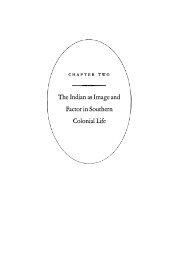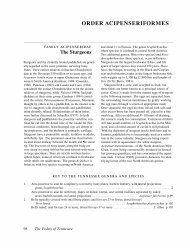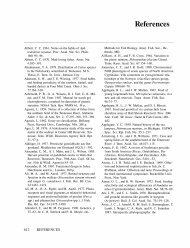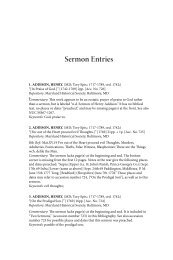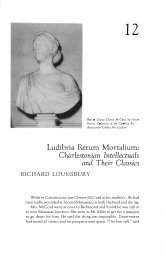James Mooney, among the Cherokee - University of Tennessee ...
James Mooney, among the Cherokee - University of Tennessee ...
James Mooney, among the Cherokee - University of Tennessee ...
Create successful ePaper yourself
Turn your PDF publications into a flip-book with our unique Google optimized e-Paper software.
“<br />
G R E A T S M O K Y M O U N T A I N S<br />
Fall 2006<br />
Volume 7 • Number 2<br />
T h e U n i v e r s i T y o f T e n n e s s e e L i b r a r i e s<br />
Wolftown ball team, October, 1888. (ALL pHoTogRApHs iN THis ARTiCLE ARE By JAmEs mooNEy.)<br />
<strong>James</strong> <strong>Mooney</strong>, <strong>among</strong> <strong>the</strong> <strong>Cherokee</strong><br />
The <strong>Cherokee</strong>s are undoubtedly <strong>the</strong> most important tribe in <strong>the</strong> United<br />
states, as well as one <strong>of</strong> <strong>the</strong> most interesting,” wrote ethnologist <strong>James</strong><br />
mooney in his 1888 article “myths <strong>of</strong> <strong>the</strong> <strong>Cherokee</strong>,” composed after his first<br />
season studying <strong>the</strong> Eastern Band <strong>of</strong> <strong>the</strong> <strong>Cherokee</strong>. He continued, “Remaining<br />
in <strong>the</strong>ir native mountains, away from railroads, and progressive white civilization,<br />
<strong>the</strong>y retain many customs and traditions which have been lost by those<br />
who removed to <strong>the</strong> West.” mooney’s initial foray into <strong>the</strong> Qualla Boundary<br />
<strong>of</strong> North Carolina would be <strong>the</strong> first <strong>of</strong> many research trips, sponsored by <strong>the</strong><br />
smithsonian institute’s Bureau <strong>of</strong> American Ethnology. His writings, an<br />
outgrowth <strong>of</strong> his lifelong fascination with Native Americans and <strong>the</strong>ir culture,<br />
provided a record <strong>of</strong> <strong>Cherokee</strong> life that was rapidly fading by <strong>the</strong> 1800s.<br />
mooney, born in Richmond, indiana in 1861, was a self-taught ethnologist,<br />
when <strong>the</strong> pr<strong>of</strong>ession was still in its nascent stages. The Bureau <strong>of</strong> American<br />
Ethnology was founded in 1879 by explorer John Wesley powell. in 1885,<br />
mooney attracted <strong>the</strong> attention <strong>of</strong> powell with his extensive independent work<br />
classifying <strong>the</strong> Native Americans by <strong>the</strong>ir languages in a document he called<br />
“indian synonymy.” This initial list provided a working manual for <strong>the</strong> staff <strong>of</strong><br />
Bureau until a more comprehensive classification was compiled 1891.<br />
During mooney’s first summer <strong>of</strong> work at <strong>the</strong> Bureau, he met N. J. smith,<br />
a representative <strong>of</strong> <strong>the</strong> <strong>Cherokee</strong>s. mooney was allowed to sit in on interviews<br />
with smith and take notes on <strong>Cherokee</strong> vocabulary and grammar. mooney<br />
asked powell permission to pursue research on <strong>Cherokee</strong> language. powell<br />
(continued on page 2)<br />
<strong>James</strong> <strong>Mooney</strong>, early ethnologist <strong>of</strong><br />
<strong>the</strong> <strong>Cherokee</strong>.<br />
Great Smoky Mountains Colloquy<br />
is a newsletter published by<br />
The <strong>University</strong> <strong>of</strong> <strong>Tennessee</strong><br />
Libraries.<br />
Co-editors:<br />
Anne Bridges<br />
Russ Clement<br />
Kenneth Wise<br />
Correspondence and<br />
change <strong>of</strong> address:<br />
GSM Colloquy<br />
652 John C. Hodges Library<br />
The <strong>University</strong> <strong>of</strong> <strong>Tennessee</strong><br />
Knoxville, TN 37996-1000<br />
865/974-2359<br />
865/974-9242 (fax)<br />
Email: smokies@utk.edu<br />
Web: www.lib.utk.edu/smokies/<br />
GREAT SMOKY MOUNTAINS<br />
REGIONAL PROJECT
G R E A T S M O K Y M O U N T A I N S C O L L O Q U Y Fall 2006<br />
----------------------------------------------------------------------------------------------------------------------------------------<br />
<strong>James</strong> <strong>Mooney</strong>, Ethnologist <strong>of</strong> <strong>the</strong> <strong>Cherokee</strong>, continued<br />
top to bottom: Tagwadihi;<br />
Ayasta; Walini; Swimmer<br />
Ayunini, <strong>Cherokee</strong> “shaman”<br />
agreed, authorizing mooney’s first<br />
field trip in summer <strong>of</strong> 1887. As<br />
well as studying <strong>the</strong> <strong>Cherokee</strong><br />
language, mooney was instructed<br />
to collect information on religious<br />
practices, customs, and arts.<br />
intrigued by traditional medical<br />
practices, mooney began his work<br />
by learning <strong>the</strong> names and uses <strong>of</strong><br />
medicinal herbs used by <strong>the</strong><br />
shamans, <strong>Cherokee</strong> spiritual and<br />
physical healers. Alarmed by <strong>the</strong><br />
high mortality rate <strong>among</strong> <strong>the</strong><br />
Eastern Band, mooney requested a<br />
medical intervention by <strong>the</strong> Bureau<br />
<strong>of</strong> indian Affairs who sent a medical<br />
team to introduce “modern” medi-<br />
cine. Fearing <strong>the</strong> sacred formulas<br />
would be lost forever, mooney<br />
moved quickly to obtain <strong>the</strong> sacred<br />
formulas recorded in <strong>the</strong> texts <strong>of</strong><br />
shamans. Although at first <strong>the</strong><br />
shamans were reluctant to reveal<br />
<strong>the</strong>ir most prized formulas to an<br />
outsider, mooney was able to<br />
convince swimmer Ayunini, a<br />
prominent <strong>Cherokee</strong> shaman, that<br />
translating and publishing <strong>the</strong><br />
formulas would preserve <strong>the</strong>m for<br />
future generations. mooney worked<br />
diligently throughout his life to<br />
translate and organize <strong>the</strong> formulas.<br />
Although mooney wrote articles on<br />
<strong>Cherokee</strong> medicine and <strong>the</strong> sacred<br />
formulas, <strong>the</strong> complete swimmer<br />
manuscript was not published until<br />
1932 when Franz olbrechts, a<br />
noted anthropologist who followed<br />
mooney in studying <strong>the</strong> <strong>Cherokee</strong>,<br />
finished <strong>the</strong> work began by mooney<br />
in <strong>the</strong> 99 th Bureau <strong>of</strong> Ethnology<br />
Bulletin in 1932.<br />
As in addition to <strong>the</strong> medical<br />
formulas, mooney was intrigued<br />
by o<strong>the</strong>r <strong>Cherokee</strong> traditions. He<br />
collected <strong>Cherokee</strong> myths which<br />
he organized into four categories,<br />
1. animal stories, 2. sacred myths,<br />
3. local legends, and 4. historical<br />
traditions. many <strong>of</strong> <strong>the</strong> myths<br />
were supplied by swimmer while additional myths were<br />
related by o<strong>the</strong>r tribal elders. The sacred myths which<br />
cover subjects like creation <strong>of</strong> <strong>the</strong> world and <strong>the</strong> origin<br />
<strong>of</strong> life and death are essential to our understanding <strong>of</strong> <strong>the</strong><br />
<strong>Cherokee</strong> world view. mooney published <strong>the</strong> myths in<br />
<strong>the</strong> 19 th Annual Report <strong>of</strong> <strong>the</strong> Bureau <strong>of</strong> American Ethnology<br />
in 1900.<br />
o<strong>the</strong>r aspects <strong>of</strong> <strong>Cherokee</strong> life drew mooney’s<br />
attention. He studied and wrote on <strong>Cherokee</strong> ball games,<br />
mound building, plant lore, names, river cult, and alpha-<br />
bets. in his second field season in 1888, he arrived with a<br />
camera to better document life <strong>among</strong> <strong>the</strong> <strong>Cherokee</strong>. The<br />
ball game with its attending rituals and dance caught his<br />
interest in particular. The sport which is common in its<br />
variations <strong>among</strong> Native Americans, resembled lacrosse,<br />
using both a netted stick and ball. The evening before<br />
<strong>the</strong> game, each opposing team held a dance within<br />
<strong>the</strong>ir community. Along with o<strong>the</strong>r food tabus, <strong>the</strong> ball<br />
players did not eat from <strong>the</strong> time that <strong>the</strong> dance began<br />
until <strong>the</strong> game was over <strong>the</strong> next day. mooney wrote that<br />
“<strong>the</strong> measured beat <strong>of</strong> <strong>the</strong> indian drum fell upon <strong>the</strong> ear,<br />
and soon we saw <strong>the</strong> figures <strong>of</strong> <strong>the</strong> dancers outlined<br />
against <strong>the</strong> firelight, while <strong>the</strong> s<strong>of</strong>t voices <strong>of</strong> <strong>the</strong> women<br />
as <strong>the</strong>y sang <strong>the</strong> chorus <strong>of</strong> <strong>the</strong> ball songs mingled <strong>the</strong>ir<br />
plaintive cadences with <strong>the</strong> shouts <strong>of</strong> <strong>the</strong> men.” During<br />
<strong>the</strong> day <strong>of</strong> <strong>the</strong> game, <strong>the</strong> players walked to <strong>the</strong> field<br />
with <strong>the</strong>ir shaman, stopping frequently to partake <strong>of</strong><br />
water rituals. Upon <strong>the</strong>ir arrival at <strong>the</strong> field, <strong>the</strong> shaman<br />
scratched each player with a kanuga or short comb with<br />
seven teeth, seven being a sacred number <strong>of</strong> <strong>the</strong> <strong>Cherokee</strong>,<br />
made from splintered turkey bones. several hundred<br />
people attended <strong>the</strong> games, meeting before <strong>the</strong> contest<br />
to wager goods on <strong>the</strong> outcome. Finally <strong>the</strong> game began,<br />
with mooney describing <strong>the</strong> action as “a combination <strong>of</strong><br />
base ball, football, and <strong>the</strong> old-fashioned shinny. Almost<br />
everything short <strong>of</strong> murder is allowable in <strong>the</strong> game….<br />
serious accidents are common.” After <strong>the</strong> game, <strong>the</strong> players<br />
again “go to water” in rituals designed to eliminate <strong>the</strong><br />
effects <strong>of</strong> <strong>the</strong> incantations <strong>of</strong>fered by <strong>the</strong> opposing team.<br />
mooney extended his research on Native Americans to<br />
include field work and publications on <strong>the</strong> Kiowa and <strong>the</strong><br />
Cheyenne as well as o<strong>the</strong>r groups in <strong>the</strong> great plains. Upon<br />
his death in 1921, he was <strong>the</strong> recognized authority on <strong>the</strong><br />
<strong>Cherokee</strong> and Kiowa, having recorded for all generations<br />
<strong>the</strong>ir traditional ways <strong>of</strong> life. The ethnologists and anthropologist<br />
<strong>of</strong> <strong>the</strong> smithsonian memorialized mooney with<br />
a resolution calling his knowledge <strong>of</strong> Native Americans<br />
“unsurpassed” and “a source <strong>of</strong> inspiration to his colleagues<br />
and associates.”
Fall 2006<br />
G R E A T S M O K Y M O U N T A I N S C O L L O Q U Y<br />
----------------------------------------------------------------------------------------------------------------------------------------<br />
For more information on mooney, see:<br />
moses, L. g. The Indian Man: A Biography <strong>of</strong> <strong>James</strong> <strong>Mooney</strong>.<br />
Lincoln, Nebraska: <strong>University</strong> <strong>of</strong> Nebraska press, 1984.<br />
“<strong>James</strong> mooney.” [obituary] American Anthropologist. New<br />
series, v. 24, no. 2 (1922): 209-14.<br />
King, Duane H. “<strong>James</strong> mooney, Ethnologist.” Journal <strong>of</strong><br />
<strong>Cherokee</strong> Studies, Special Issue, A Tribute to <strong>James</strong> <strong>Mooney</strong>,<br />
<strong>Cherokee</strong> Ethnologist, v. 7, no. 1 (1982): 4-8. This issue<br />
includes reprints <strong>of</strong> several articles by mooney.<br />
<strong>Mooney</strong> on <strong>the</strong> Web<br />
Visit <strong>the</strong> new “<strong>Cherokee</strong> Resources guide” on <strong>the</strong><br />
UT Libraries webpages at www.lib.utk.edu/refs/<br />
cherokee for pDF versions <strong>of</strong> several <strong>James</strong> mooney<br />
articles and links to information on <strong>the</strong> <strong>Cherokee</strong>.<br />
Cades Cove and Abrams Creek:<br />
Legacy <strong>of</strong> <strong>the</strong> <strong>Cherokee</strong>?<br />
T here has long been dispute in <strong>the</strong> annals <strong>of</strong> smoky<br />
mountain lore concerning <strong>the</strong> origin <strong>of</strong> <strong>the</strong> name<br />
“Cades Cove.” one tradition contends that Cades Cove<br />
was named for Chief Kade, a <strong>Cherokee</strong> and little-known<br />
successor to old Abram <strong>of</strong> Chilhowee, who himself was a<br />
warrior chief famous for leading <strong>the</strong> <strong>Cherokee</strong> against <strong>the</strong><br />
Watauga settlement.<br />
old Abram, along with Chief old Corn Tassel, Chief<br />
Hanging maw, and three o<strong>the</strong>r <strong>Cherokee</strong> warriors, were<br />
tomahawked to death in 1788 by a man named Kirk in<br />
revenge for <strong>the</strong> massacre <strong>of</strong> his family at Nine mile in <strong>the</strong><br />
present Blount County, <strong>Tennessee</strong>. This Kirk is reputed<br />
to be <strong>the</strong> son <strong>of</strong> John Kirk, a soldier who served with<br />
Colonial John sevier during <strong>the</strong> Revolution.<br />
old Abram’s mohawk wife, Kate, <strong>the</strong>ir daughter, and<br />
several <strong>Cherokee</strong> women were spared Kirk’s tomahawk.<br />
old Abram’s legacy as an honored leader <strong>of</strong> his people was<br />
memorialized in <strong>the</strong> name Abrams Creek, a large stream that<br />
runs through <strong>the</strong> bottom land <strong>of</strong> Cades Cove. According to<br />
some accounts, Kate’s name also survives in <strong>the</strong> derivation<br />
“Cades” and thus in remembrance as “Cades Cove.”<br />
New on <strong>the</strong> Smokies Bookshelf<br />
Charles Frazier. Thirteen Moons.<br />
Ny: Random House, 2006. 422 p.<br />
“<br />
so <strong>the</strong> lesson that <strong>the</strong> map<br />
taught was that knowledge<br />
has strict limits, and beyond that<br />
verge <strong>the</strong> world itself might become<br />
equally unspecified and provisional,”<br />
mused young Will Turner as he<br />
headed into uncharted <strong>Cherokee</strong> William Holland Thomas:<br />
territory for <strong>the</strong> first time in Charles The real Will Turner?<br />
Frazier’s second novel, Thirteen Moons.<br />
With a setting firmly in <strong>the</strong> Blue Ridge/smokies region<br />
<strong>of</strong> North Carolina, Turner makes his way in <strong>the</strong> world in<br />
a classic heroic journey tale that shadows <strong>the</strong> life <strong>of</strong> <strong>the</strong><br />
historic figure, William Holland Thomas. The major<br />
derivation from Thomas’s story is Turner’s mysterious love<br />
interest, Claire, who periodically appears and disappears,<br />
haunting both his dreams and consciousness.<br />
Turner comes to <strong>Cherokee</strong> territory as a bound boy,<br />
contracted to run a store. He stays, learning to speak<br />
<strong>Cherokee</strong> like a native, building a commercial and real<br />
estate empire, and joining <strong>the</strong> <strong>Cherokee</strong> community<br />
through his adoption by Bear, a local <strong>Cherokee</strong> patriarch.<br />
The upward trajectory <strong>of</strong> Turner’s life is a distinct contrast<br />
to <strong>the</strong> fragile and deteriorating condition <strong>of</strong> <strong>the</strong> <strong>Cherokee</strong>,<br />
culminating in <strong>the</strong>ir forced removal in <strong>the</strong> 1838 Trail <strong>of</strong><br />
Tears. Like <strong>the</strong> real life Thomas, Turner becomes an advocate<br />
for <strong>the</strong> <strong>Cherokee</strong> who manage to remain in North Carolina,<br />
first as a lobbyist in Washington, DC and later as a senator.<br />
smokies enthusiasts will appreciate Frazier’s depictions <strong>of</strong><br />
<strong>the</strong> wilderness mountain region and <strong>the</strong> <strong>Cherokee</strong> way <strong>of</strong> life.<br />
<strong>of</strong> <strong>the</strong> <strong>Cherokee</strong>, Turner says that even before <strong>the</strong> removal <strong>the</strong>ir<br />
way <strong>of</strong> life had changed from “<strong>the</strong> companionable townships<br />
with <strong>the</strong>ir warm smoky townhouses and constant gossip and<br />
intrigues and friendships and quarrels and romances. some<br />
had even forgotten <strong>the</strong>ir old names and went only by white<br />
sort <strong>of</strong> names, like sam Johnson or John samson.” in fur<strong>the</strong>r<br />
thinking about <strong>the</strong> role <strong>of</strong> <strong>the</strong> white people as “victors,” he<br />
comments that “a few rivers and creeks and coves seem to be<br />
resistant to our ownership. They persist in holding on to <strong>the</strong>ir<br />
old names even into <strong>the</strong> present. Unfortunately, hardly any<br />
<strong>of</strong> <strong>the</strong> mountains have kept <strong>the</strong>ir real names, which is understandable<br />
since <strong>the</strong>y make such grand ways to commemorate<br />
our dead politicians.” Through historic detail and thoughtful<br />
descriptions, Thirteen Moons enriches our understanding in<br />
this critical frontier period <strong>of</strong> <strong>the</strong> smokies region.
G R E A T S M O K Y M O U N T A I N S C O L L O Q U Y Fall 2006<br />
----------------------------------------------------------------------------------------------------------------------------------------<br />
An 1886 Trip to <strong>the</strong> Smokies<br />
Now on <strong>the</strong> Web<br />
The great smoky mountains Regional project is<br />
pleased to announce <strong>the</strong> availability <strong>of</strong> <strong>the</strong> William<br />
Cox Cochran great smoky mountains photographic<br />
Collection. Cochran, an ohio lawyer and trustee <strong>of</strong><br />
oberlin College, captured <strong>the</strong> 89 images in this collection<br />
while on a trip to East <strong>Tennessee</strong> in August 1886.<br />
The photographs consist largely <strong>of</strong> images <strong>of</strong> people and<br />
landmarks in and around what is now <strong>the</strong> great smoky<br />
mountains National park. The photographic images<br />
were donated by miss mary Rudd Cochran, daughter <strong>of</strong><br />
W.C. Cochran, to <strong>the</strong> <strong>University</strong> <strong>of</strong> <strong>Tennessee</strong> Library<br />
in 1959.<br />
The Cochran Collection, along with o<strong>the</strong>r smokies<br />
digital collections, can be seen at: www.lib.utk.edu/<br />
smokies/digcoll.html.<br />
GREAT SMOKY MOUNTAINS<br />
REGIONAL PROJECT<br />
GSM Colloquy<br />
652 John C. Hodges Library<br />
The <strong>University</strong> <strong>of</strong> <strong>Tennessee</strong><br />
Knoxville, TN 37996-1000<br />
Dorsey’s cabin in Middle Fork <strong>of</strong> <strong>the</strong> Little River. Photograph by<br />
William Cox Cochran. (WiLLiAm Cox CoCHRAN gREAT smoKy<br />
moUNTAiNs pHoTogRApH CoLLECTioN, 1886, spECiAL CoLLECTioNs<br />
LiBRARy, THE UNiVERsiTy oF TENNEssEE)<br />
L O O K I N G F O R A B A C K I S S U E O F T H E C O L L O Q U Y ? G O T O :<br />
w w w . l i b . u t k . e d u / s m o k i e s / c o l l o q u y. h t m l


